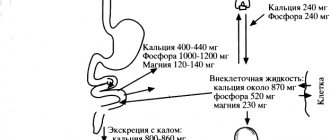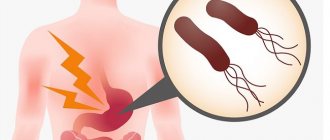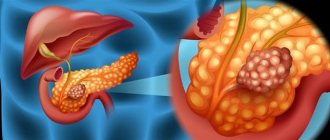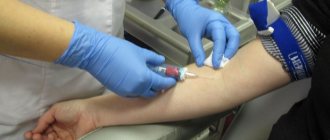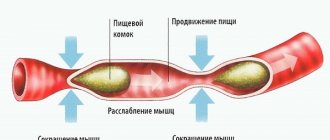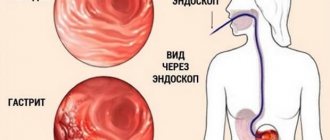Reasons for deviations in the level of diastase in urine
Note that diastase activity does not depend on gender; the norm in women and the norm in men are the same.
Concentration is largely dependent on the time of day, food intake and food quality. An increase in enzyme activity in urine says:
Pancreatitis
- About pancreatitis (chronic or acute, depending on the degree of increase. In adults, in the case of chronic pancreatitis, the concentration increases moderately (slowly) over a long time);
- The presence of polyps in the pancreas or gall bladder;
- About liver diseases, including hepatitis;
- About cholelithiasis or inflammation of the bile ducts;
- About various abdominal injuries that can interfere with the normal functioning of the pancreas;
- About exacerbations of diseases of the gastrointestinal tract (for example, with ulcers and colitis);
- About oncological diseases of the abdominal organs;
- About diabetic crises, etc.
It is important to know that an increase in the amount of diastase in the urine is facilitated by taking certain medications - antibiotics and drugs that contain elements of narcotic effects. . The reasons for the decrease in diastase activity in urine are
The reasons for the decrease in diastase activity in urine are
- Removed pancreas;
- Pancreatitis (note that the norm in adults with pancreatitis can increase and decrease, depending on the secretory activity of the glands);
- Diabetes;
- Damage to the function of the salivary glands;
- Hepatitis;
- Acute appendicitis;
- Cystic fibrosis.
Deviation from the norm of diastase concentration in urine during pregnancy
When the level of the enzyme in the urine increases in pregnant women, a process called hyperamylasuria can occur as a result of the same pancreatitis, as well as mumps or other infectious diseases, but the main cause, as a rule, is ectopic pregnancy, in which diastasis can be increased in as many as 10 times. The same applies to the level of alpha-amylase in the blood, which in the latter case deviates (increases) from the norm by 8 times.
Other urine parameters with elevated alpha-amylase
An increase in diastase in urine can be determined visually. In acute pancreatitis, the color of urine becomes dark. This is directly related to an increase in diastase.
In parallel with the increased level of the enzyme, acetone, acetoacetic and hydroxybutyric acids appear in the urine. These are signs of acute pancreatitis. Ketone bodies are not normal and a good urine test does not contain the listed indicators.
Inflammation of the pancreas, accompanied by kidney damage, provokes the release of protein, red blood cells, white blood cells and casts into the urine.
How to obtain a sample for analysis
An important point is to comply with certain rules when submitting such material, since there are a number of factors that significantly influence the test results. For example, contamination of the container in which urine is collected or poor personal hygiene can distort the clinical picture.
Urine collection for diastase analysis
So, let's look at what you need to know about preparing for analysis.
- A sample of the test material is taken on an empty stomach;
- Only morning urine is suitable for analysis (it is important to know that if the collected sample is left to infuse for a long time, the material may reduce its suitability for analysis (many people mistakenly keep the collected urine from several hours to a day, sometimes they put it in the refrigerator, which is contrary to all the rules for taking tests ));
- Urine is collected in minute quantities in a special container (it can be purchased at pharmacies);
- When a sample is collected, it should be taken to the laboratory immediately;
- On the eve of such an analysis, it is recommended to give up alcoholic beverages;
- You need to drink a lot of liquid.
To identify the level of diastasis, a biochemical examination of blood taken from a vein is performed. Just as with a urine test, blood is taken on an empty stomach, and before donating it, it is recommended to avoid spicy, fatty and heavy foods.
»>
Urine diastasis is normal
An increase or decrease in amylase concentration in urine serves as an informative marker when examining a patient and making a diagnosis.
This analysis, in combination with other studies (assessment of laboratory blood parameters, ultrasound), allows both to diagnose pathological processes in the pancreas and salivary glands, and to adjust the course of therapy for early identified diseases.
Urine diastasis is examined if the following symptoms are present:
- girdle pain in the upper abdomen radiating to the back;
- nausea, lack of appetite, vomiting;
- feverish state against a background of nausea and general malaise;
- pain and swelling of the salivary glands (parotid).
The reliability of the result may be affected by coughing, taking certain groups of medications (diuretics, hormonal drugs, panthezocin, corticosteroids), pregnancy, foreign particles entering the urine sample, and drinking alcohol before taking the test.
There is no single classification of diastase norm indicators , since different laboratories use different methods and different reagents for analysis.
The most common are amylase indicators, which are estimated in units per liter or units per hour.
Table - reference limits for diastase activity values.
| U/l | U/h | |
| Children | 10-64 | 1-17 |
| Adults (up to 60 years old) | 20-125 | |
| Elderly (60 and above) | 25-160 |
Analysis transcript
To establish the rate of diastase in the urine of an adult, certain reagents are used in the laboratory.
Correct data is obtained only after using 0.85% saline solution, starch and phosphate buffer solution, toluene. The laboratory assistant heats 80 g of saline solution and brings it to a boil. A second test tube is used, to which 3 ml of cold solution is added. The composition is mixed with 1 g of liquid starch. The components are mixed well, for which a special glass rod is used. The number of units for each liter of urine is equal. It is enough to conduct one accurate analysis to determine the presence of pathological changes.
The resulting mixture of 2 components is added to a boiling saline solution, mixed using a glass rod and cooled. After cooling, the composition is added to a 100-milligram flask up to the special mark on the container.
Next step: the starch is mixed with the resulting mass from saline solution. Exactly 90 ml of liquid should come out. Add 10 ml of toluene, 10 ml of buffer solution. The specialist prepares 20 ml of iodine dissolved in 80 ml of water.
Urine analysis uses 15 tubes. In 14 of them, 1 ml of saline solution is added. Urine is added to 2 test tubes and mixed with saline solution.
Another 1 ml of solution is added to the next 2 test tubes and mixed with urine. Further operations are carried out identically to the previous steps, reaching the 15th test tube. A small amount of liquid is poured out from there so that the material comes out equally everywhere.
The study continues by adding 2 ml of starch solution to the test tubes. The contents are left for a quarter of an hour, all materials are placed in a water bath with a temperature of 45o. Afterwards, the stand is placed under cold water for rapid cooling and the speedy termination of the enzyme action.
Explanation and designation of amylase content are available after the next step. Iodine mixed with water is placed into the test tubes, and laboratory assistants begin to monitor the contents.
If everything is done correctly, the composition changes color from yellow to blue, red, or red-blue. The special color disappears in about 3 minutes. If the solution becomes discolored faster, add another drop of iodine.
Next, the laboratory assistant determines the amount of diastase. When the liquid turns blue, the specialist concludes that no diastatic action is observed.
The previous test tube is taken. For example, if starch remains in test tube 7, test tube No. 6 is used. The result is as follows: 2 ml of starch reacts in the resulting amount of the composition. Each tube contained a different amount of urine mixed with saline solution.
In children, as in adults, the composition shows possible deviations. 32 ml of starch should dissolve in 1 liter of urine. Taking into account the previous steps, it is determined how much urine dissolves the established rate of starch.
If the amount of alpha-amylase in the urine is high, the indicator is in the range of 128-256, a possible diagnosis is any form of pancreatitis.
How to take the test correctly
To avoid errors when interpreting tests, it is necessary to correctly collect urine.
To do this, you must strictly adhere to the following rules :
- The day before urine collection, you should not drink alcoholic beverages.
- During the two to three days preceding urine collection, you should stop taking all medications that may affect the composition of urine.
- Two hours before urine collection, you can only drink water.
- Urine fluid is collected only in the morning, in a sterile container that can be purchased at a pharmacy.
- Only the “middle portion” is collected: at the beginning of urination, you need to urinate into the toilet for a few seconds, and only then into the container. The last drops of urine fluid should also not fall into the collection container.
- The material must be delivered to the laboratory no later than two hours after collection.
Urine test for alpha-amylase enzyme
Urine samples to determine amylase levels are taken strictly in the morning. In this case, the material must be fresh and clean, so the patient must use disposable sterile collection containers. Failure to comply with the rules for collecting material for analysis may show inaccurate results that will mislead the doctor. In the case of differential diagnosis, the time of sampling from the patient does not play a special role. A small amount of urine is enough to study diastase (even a few drops), the main thing is that it is delivered to the laboratory as quickly as possible (that is, still warm). If the material sits for more than 1 hour (it does not matter whether it is in an open or closed container), the enzyme may be destroyed, which will significantly affect the result.
What determines
Diastase (alpha-amylase) is synthesized in the pancreas and salivary glands, as well as in the mucous membrane of the small intestine (in women, such enzymes are additionally formed in the ovaries).
With a lack of such an enzyme, starch is incompletely broken down , which accumulates in the body or is partially excreted.
Such deposits can provoke the development of various pathological processes.
In the process of establishing the level of diastase in urine, laboratory assistants use special reagents (toluene, phosphate buffer solution, 0.85% starch solution and saline solution).
Saline solution is taken in an amount of 70 grams and brought to a boil, after which 3 milliliters of this substance is poured into a separate sterile tube and mixed with one milliliter of starch solution.
After thorough mixing, the mixture is poured into a container with boiled saline solution, the preparation cools and is poured into another flask to the mark indicated on it. 10 milliliters of buffer solution and toluene are added to the same flask
The last step is preparing an iodine solution (iodine is diluted with water in a ratio of 2:8, a total of 100 milliliters of the product should be obtained).
Then
to 14 test tubes installed in a stand, the urine of the subject is added to the first clean test tube and to one of the test tubes with saline solution.
After this, the contents of the second and third tubes are mixed, and then the manipulations are repeated for all fifteen tubes. As a result, in each of the subsequent containers, the concentration of urine decreases proportionally, and one milliliter of the contents is poured out of the last test tube so that the amount of liquid in all containers is the same.
Children's Study
A urine test for diastase (amylase) is taken in children. In order to correctly diagnose the disease, doctors carefully study the results of all laboratory tests and tests, taking into account the detected level of diastase in the urine.
Important! The norm for children is the content of amylase in the urine from 10 to 64 units.
When the enzyme level increases, a signal is given to the attending physician about dysfunctional processes in the child’s body. Elevated enzyme levels may indicate pathological processes in the child’s body: colitis, ulcers, pancreatitis and appendicitis. Decreased levels below normal may also herald certain diseases, such as diabetes or kidney failure.
The level of enzyme in a child’s urine is determined by laboratory tests of biological substances. It is important to take into account the fact that some medical laboratories may have different units of measurement. Therefore, quantitative data on the enzyme may differ. In this case, the doctor must compare all the data from the studies performed and only after that draw up his conclusion and make a diagnosis.
Diastase standards in urine
Determining the level of activity of the enzyme in question in the consistency of urine is important because it not only helps to recognize a disease specifically of the pancreas, but also disorders in other organs of the human body. The reason is that quite a few disruptions in the body have a tangible effect on the alpha amylase enzyme
Normal urine diastasis in adults
Food intake and quality
The norm in adults during the day varies depending on several factors - for example, food intake and the quality of food taken, the amount of water drunk. In addition, in adults, indicators begin to fluctuate precisely due to age-related changes. Therefore, the indicator that is considered the norm is very general (generalized) and can vary depending on individual circumstances.
However, doctors name approximate standards - so, the norm for adults is:
- In adults from 17 to 60 years old, 10-124 units/l is considered a sign of health;
- In elderly people over 60 years of age, the norm ranges from 25 to 164 units/l;
- It is often necessary to additionally check the level of alpha-amylase in the blood to ensure the reliability of the results. In this case, in adults the norm is 10-100 units/l.
Urine diastasis in children
In children, the pancreas is smaller and, accordingly, the production of enzymes occurs in relatively smaller quantities. The norm for children under 2 years of age is the concentration of diastase in the urine from 10 to 64 U/L, due to the fact that the need for complex carbohydrates in infants is minimal. From 2 years onwards, in adolescence up to 18 years, the activity of alpha-amylase in the urine increases, ranging from 25 to 125. The same situation is with the blood - in children under 2 years of age, the enzyme concentration should normally be from 5 to 64 (indicators increase with age to 125).
Deviation from the norm in children is most often evidence of renal failure or diabetes mellitus.
It is important to remember that different laboratories accept different indicators as normal.
Under the following circumstances, an analysis of diastasis in urine is prescribed:
- If you suspect chronic or acute pancreatitis;
- If you suspect inflammation of the pancreas;
- If cholecystitis is suspected;
- If liver failure is suspected;
- For acute pain in the epigastric zone, when the cause could not be identified.
Urine diastasis in children
Amylase in children, just like in adults, is produced in the pancreas, and an increase in its level indicates damage to the organ. The only difference is the reduced secretion of the enzyme, so urine diastasis has lower normal levels in young children. In newborn children, the enzyme is practically absent in the urine. However, with age, amylase production increases, which is associated with an expansion of the diet. Children are often prescribed an additional blood test for pancreatic amylase.
Reference values:
| Child's age | In blood | In urine |
| Children under one year old | Up to 60 units/l | From 10 to 60 units/l |
| children over one year old | Up to 120 units/l |
Pancreatic amylase in newborns can be in the range of 6–8 U/L. Small deviations are normally allowed in children; it is important to pay attention to the child’s well-being when interpreting the results of the study.
Pathologies that can increase the level of diastase in children:
- mumps (mumps),
- peritonitis,
- diabetes,
- pancreatitis.
A fall from a height, general intoxication of the body, liver damage and neoplasms in the pancreas can reduce the enzyme content. All children are prescribed routine urine tests in the first month of life, at six months of age and at one year. This makes it possible to detect abnormalities at an early stage of the disease.
How to properly collect urine from babies? In infants, this must be done using a urine bag; older children should be washed before taking the test. The day before collection, you should not feed your babies fruit. Only morning urine should be collected and it is important to get the sample to the laboratory within two hours.
Research results
Interpretation of the results must be carried out taking into account the fact that each laboratory has its own standard indicators. Therefore, when interpreting, it is necessary to take into account the general well-being of the person and the complaints presented by him.
If the urine was collected taking into account all the recommendations, the patient will be confident in the accuracy of its results. This guarantees the accuracy of the diagnosis and the correct treatment.
However, the analysis results sometimes turn out to be incorrect due to the influence of various factors. The test results may be distorted if the patient violated the rules for collecting urine. Taking certain substances and medications leads to incorrect results. Factors that negatively affect the bottom line:
- antibiotics of the tetracycline group;
- drugs containing adrenaline;
- narcotic analgesics;
- non-steroidal anti-inflammatory drugs;
- drugs;
- gold-based preparations.
Antibiotics of the tetracycline group
Diastase indicators may also be unreliable if the patient was taking blood thinners, hormonal contraceptives, or diuretics.
An incorrect diagnosis based on urine diastase analysis occurs if the urine was collected in an unclean container. False readings may be due to contamination of the obtained biological material. In addition, the result is unreliable when the person taking the test had a cold or infectious disease accompanied by a cough.
To exclude an incorrect diagnosis when receiving test results different from the norm, it is recommended to conduct a repeat analysis. A diagnosis made on the basis of these indicators should be confirmed only after a thorough examination.
Before collecting tests, the patient is required to consult a doctor; this will help avoid controversial issues and conflicts when obtaining the result. All symptoms of the body must be reported to the doctor in advance; do not remain silent about hereditary diseases or allergic reactions, seasonal colds.
What causes a decrease in diastase levels?
In adults, enzyme concentrations are reduced due to several conditions. First of all, with chronic pancreatitis, since the disease occurs with a decrease in the functions of cells that secrete amylase. The same picture is observed in children.
The enzyme level drops significantly after removal of the pancreas. The reasons for the phenomenon are clear: no organ - no enzyme.
A decrease in diastase is caused by hepatitis, its acute or chronic form, cystic fibrosis, colitis, poisoning, including certain drugs, alcohol or drugs. The level of amylase falls with exacerbation of thyrotoxicosis, and in rare cases, toxicosis of pregnant women.
It is worth remembering that the concentration of the enzyme changes during the day, and accordingly, urine tests will have different results. Other factors influence the information content and accuracy of analyzes, so there is a clearly defined algorithm for preparing and submitting material.
Interpretation of research materials
Interpretation of analysis data should be carried out by an experienced doctor, preferably with a specialization in endocrinology or gastroenterology. In his conclusions, he relies on generally accepted norms, which have slight differences for different age categories. At the same time, the rate of diastase in the urine will not differ between women and men of the same age.
In adults from 17 to 56–60 years of age, diastasis in urine is 10–124 U/L. Whereas the norm in older adults will be in the range of 25–160 units/l. For children, this figure is 10–64 units/l. Any values above or below these limits will be considered anomalies and additional investigations will likely be required.
Increasing values
The highest levels of diastase in urine are observed in acute pancreatitis or inflammation of the pancreas, when a cyst forms in it or in the initial stages of a malignant process. In the diagnosis of these pathologies, diastase parameters play an important role - they provide an opportunity to identify diseases in the early stages.
For example, with pancreatitis or a tumor, the indicator can be increased to 128–256 units/l, which will immediately indicate to the doctor the presence of a pathological process in the tissues of the organ. An increase in values, but not more than 10 times, is often observed with inflammation of the salivary glands, caused by mumps, as well as with cholecystitis (inflammation of the gallbladder).
And diastase rates also increase in acute kidney pathologies of an infectious nature, such as glomerulonephritis, pyelonephritis, which can lead to reversible renal failure. In case of irreversible renal failure, urinary diastase levels are always elevated.
Lipase in blood test
Less common causes of increased digestive enzyme values include:
- chronic pancreatitis - initially, the indicators increase moderately, but then they can decrease to normal as the pancreatic tissue is damaged;
- injuries (impact, bruise) of the pancreas;
- neoplasms of a malignant nature;
- blockage of the gland duct with a stone or scar;
- acute peritonitis, appendicitis;
- perforation (perforation) of a stomach ulcer;
- diabetic ketoacidosis (decompensation of diabetes mellitus);
- surgical intervention on the abdominal organs;
- interrupted tubal pregnancy;
- intestinal obstruction;
- rupture of an aortic aneurysm.
In addition to the above, significantly increased diastase rates can be observed during pregnancy accompanied by toxicosis, as well as in persons suffering from alcoholism.
Decrease in indicators
Reasons for decreased diastase activity in urine:
- pancreatic insufficiency;
- removal of the pancreas, severe hepatitis;
- thyrotoxicosis, intoxication of the body;
- cystic fibrosis (cystic fibrosis) is a serious genetically determined disease of the endocrine glands;
- macroamylasemia is a fairly rare benign metabolic disorder in which amylase binds to large protein molecules in the plasma, as a result of which it cannot penetrate the glomeruli.
Attention! In a child, in the first 2 months of life, diastase activity is quite low, and it increases to the level of an adult only after he reaches the first year.
Using a urine test for diastasis, mumps can be detected in the early stages
What is the danger of pancreatitis?
Blood tests with elevated levels of lipase and diastase usually confirm pathology in the pancreas, in particular inflammation of the organ, pancreatitis.
More on the topic: How is a bladder fistula treated?
It can also be determined by the symptoms in a person who experiences pain in the back and stomach, fever, lack of appetite, prolonged vomiting and constant nausea. These symptoms are too general, which is typical for ectopic pregnancy, appendicitis, and intestinal blockage. Only with the help of an analysis for diastasis can one identify the involvement in the unpleasant symptoms of the pancreas, its pathology, and prescribe the necessary treatment. Urine and blood tests are taken simultaneously, and the results are compared with the norm.
Acute pacreatitis
If pancreatitis is acute, amylase in the blood is several times (4-6) higher than normal. Amylase increases within 6 hours from the moment the pancreas malfunctions and remains within elevated limits until the cause of this pathology is eliminated. It takes several days for diastasis to return to acceptable limits, provided that the treatment is adequate.
With an exacerbation of pancreatitis, amylase increases along with the growth of lipase, which remains at high levels in blood tests much longer. But clinical medicine considers amylase tests to be more accurate in diagnosing inflammation of the pancreas, especially in cases of alcoholic acute pancreatitis.
Pancreatitis
Chronic pancreatitis
Chronic pancreatitis is characterized by a slight increase in amylase in the blood with its gradual decrease depending on the rate of breakdown of the pancreas. Chronic inflammation with normal amylase does not mean elimination of the cause and recovery. Treatment should continue, since low diastase in human urine and blood with pancreatitis means irreversible disorders in the tissues of the gland responsible for the production of amylase.
If there is any suspicion of pancreatitis, it is necessary to take both tests, amylase and lipase. The chronic form is most often caused by alcoholism. Moreover, inflammation of the organ can be due to injury or blockage of the ducts in the pancreas, fibrous cysts or structural abnormalities.
More about diastasis
Alpha amylase is one of the most important digestive enzymes included in diastase, which breaks down starch into simple carbohydrates. Its synthesis also occurs in the small intestine and in women in the ovaries. Amylase is found in saliva, and therefore the digestive process begins precisely under its influence.
Historical fact! Amylase was discovered in 1833 by Anselme Payen, a French chemist, when he first described diastase (a mixture of enzymes) that broke down starch into maltose. According to other sources, amylase was discovered by K. S. Kirchhoff, an academician of the St. Petersburg Scientific Academy in 1814.
It is amylase that causes the appearance of a sweetish taste when chewing foods containing starch (potatoes, rice) for a long time, but without added sugar. Moreover, the activity of this enzyme in the urine is directly related to the activity in the blood serum, therefore, to study its content, a urine test for diastase is performed.
Based on the number of enzymes in the test material, the doctor is able to draw a conclusion about the functional state of the pancreas and identify the presence of pathologies, in particular pancreatitis. Along with other enzymes involved in the digestive processes, diastase enters the stomach, then the intestines, from there it is absorbed into the blood, after which it is absorbed by the kidneys and excreted along with the urine.
Normally, a small amount of enzymes from the pancreas and salivary glands circulates in the bloodstream (this occurs due to cell renewal). But when the pancreas is damaged, which is most often associated with the development of pancreatitis or when the gland duct is blocked by a stone or tumor, enzymes begin to enter the blood and then into the urine in larger quantities. This formed the basis of the study.
In addition, given that, for example, amylase is also produced by the salivary glands, its increased activity in the urine may be caused by pathologies of these organs. In any case, such changes should not be ignored, but, on the contrary, the patient will need to undergo a full examination.
Etiology of increased diastase levels
If a specialist suspects the formation and progression of pathological changes in the pancreas, to confirm and make an accurate diagnosis, urine may be needed to conduct laboratory tests and obtain a clear clinical picture.
With normal functioning of the pancreas, the norm of diastase, as already mentioned, does not exceed 64 units. But, with an exacerbation of the inflammatory process in the pancreas, a urine test for pancreatitis may show an excessively high level of compounds of the enzyme being studied, exceeding the permissible norms by 250 times, that is, up to 16,000 units.
The level of diastase in the urine reaches high levels not only in acute pancreatitis, but also in the progressive stage of other inflammatory processes in the peritoneum, such as cholecystitis, or a purulent form of appendicitis. The etiology of this level of bioblocker may be taking the following medications:
- adrenalin;
- tetracycline;
- antitumor drugs;
- non-steroidal group of anti-inflammatory drugs.
Surgical abortion, regular use of opiates, as well as intoxication of the body with alcoholic beverages can provoke a similar release of enzymes into the blood.
The content of excess alpha-amylase is considered a natural phenomenon in cases of diabetes mellitus. After all, both diabetes mellitus and pancreatitis develop against the background of impaired functionality of the pancreas, which means that in both cases the presence of glucose compounds in the urine may well be present, which leads to an increase in the level of the biocatalyst diastase, which it breaks down.
Pathological dysfunction of the renal organ system is also the cause of excess enzyme content, but its distinctive feature is the presence of a high concentration of urea and keratin in the biomaterial under study.
The development of mumps, or as it is popularly called “mumps,” is a childhood pathology, but in some cases, an inflammatory process in the salivary glands can begin in an adult. Analyzes of biomaterials during the progressive stage of this disease, as a rule, also show an increased level of amylase, but its concentration is not as critical as in the development of pancreatitis or diabetes mellitus.
What does an excess of alpha-amylase indicate?
If the content of urine diastase is not normal, then this may indicate a number of diseases of the gastrointestinal tract. If this indicator exceeds 125 units for persons aged 16 to 55 years, then this indicates the presence of an inflammatory process in the pancreas - the doctor is likely to diagnose acute pancreatitis or an exacerbation of its chronic form.
If the alpha-amylase level is in the range of 450-520 units in patients of different ages, then this indicates a violation of the outflow of pancreatic fluid, as a result of severe inflammation of the gland. Urine diastasis has increased to 1000 units per 1 liter of natural human secretions - severe damage to the pancreas is observed (for example, benign and malignant neoplasms) and in this case, urgent hospitalization of the patient will be required. It is worth keeping in mind that excessively high amylase levels last for 3-5 days, then decrease, but this does not mean a retreat or weakening of the disease - additional research will be required.
Urine amylase in pancreatitis is always increased by 30-40 units.
A high level of diastase, although not significantly, indirectly indicates an inflammatory process in the gastrointestinal tract to a greater or lesser extent.
How to properly collect urine
Options for determining alpha-amylase in urine:
- Determination of concentration in TAM. This method is most applicable in practice, most often used in the emergency department of a hospital to confirm acute pancreatitis. The patient urinates into a sterile container, which is then sent to the laboratory.
- Estimation of the enzyme level in a portion collected over 2 hours or 24 hours. The patient urinates in a small sterile container and drains the urine into a prepared container over a period of 2 or 24 hours. All this time it is stored in the refrigerator. At the end of collection, the contents of the container are mixed, a small portion is taken from it, which is sent to the laboratory.
Reasons for deviations of the analysis indicator from the norm
If diastasis is increased, it is always associated with inflammation. The highest levels of diastase in urine are observed in the following diseases:
- Acute and chronic pancreatitis. The test result may be above 250 units during the acute period of the disease, and values above 500 units indicate blockage of the gland duct. But if in a urine test with pancreatitis, diastase indicators have decreased to normal, this does not always indicate a cure. Sometimes a decrease in enzymes can be associated with a serious complication - pancreatic necrosis. In this case, the pancreatic cells that produce diastase die.
- Diabetes. Normal values are increased 10 times or more.
- Mumps (mumps). The enzyme increases several times.
In other inflammations, the enzyme is slightly elevated. This may occur with the following pathologies:
- acute appendicitis;
- cholecystitis;
- pyelonephritis;
- cystitis;
- gastritis;
- colitis;
- peritonitis.
It can be concluded that the highest rates of diastase are observed in pancreatic diseases and inflammatory processes in the salivary glands. But an increase in the enzyme does not always indicate pathology.
»>
If the filtration function of the kidneys is impaired, a high level of diastase may be detected in the urine, but in this case the analysis will not have diagnostic value. Therefore, in case of kidney diseases, the study is not prescribed; its results will not be reliable. The enzyme can also be increased in the following cases:
- when taking medications (Tetracycline, narcotic analgesics, antitumor drugs, non-steroidal anti-inflammatory drugs, Adrenaline, anticoagulants, hormonal contraceptives);
- after drinking alcohol;
- after examination using retrograde cholangiopancreatography;
- when saliva gets into the test samples;
- in patients with drug addiction.
Reduced diastase rates are observed much less frequently. The reason for this may be the first trimester or toxicosis of pregnancy, hepatitis, cystic fibrosis. A zero level of the enzyme indicates that the pancreas is not functioning.
Norm of analysis
During the study, a quantitative indicator of an enzyme is determined that is capable of breaking down a certain amount of starchy substance over a certain period of time. To conduct this test in a clinical laboratory, solutions of phosphate, starch and toluene are used.
For the results of the study to be true, it is best to submit your morning urine for analysis.
Important! The enzyme level according to the established norm is indicated between 16 and 64 units.
If the level of the substance is not more than 64, the patient under study is considered absolutely healthy. Elevated levels of the substance indicate the presence of inflammatory processes in the pancreas in the patient’s body. They can also be detected as a result of the negative effect of other diseases on the body, such as pancreatitis or cholecystitis.
Amylase levels can fluctuate throughout the day, so it is best to do a 24-hour urine test. An increase in the level of the substance is also affected by taking medications such as antitumor drugs, tetracycline, adrenaline and others. The enzyme level also increases in case of alcohol poisoning or after an induced abortion. Drug addicts taking drugs of the opium group also experience a quantitative increase in the level of the test substance.
Increased diastase (amylase)
Diabetes mellitus contributes to an increase in amylase levels above normal, while glucose content is detected in urine, which should not be present in accordance with the norm. With pancreatitis, glucose content in urine is also detected. To diagnose these two serious diseases - pancreatitis and diabetes mellitus, which affect the pancreas, it is not enough just to determine the quantitative level of the enzyme; a full examination using various methods and tests is necessary.
When the disease occurs in patients with renal failure, during the study an increase in this enzyme is also observed, while an increased content of creatinine and urea is detected in the urine. With inflammation of the salivary glands, with diseases such as sialadenitis and mumps, the level of the biologically active substance also increases above normal.
Therefore, we can conclude that increased amylase levels will help diagnose the following diseases:
- Inflammation of the gallbladder
- Diabetes mellitus
- Kidney failure
- Pancreatic oncology
- Pancreatitis
- Appendicitis
- Intestinal obstruction
- Viral infection
- Abdominal peritonitis.
Decreased diastase
Reduced levels of this substance in the urine are detected in patients with chronic pancreatitis, who have developed a deficiency in the enzyme formation function over time. Therefore, the level of the diastase enzyme in their urine is below the normal level of 16 units.
Hepatitis can also lead to a decrease in the content of the test substance in the patient’s urine, especially in acute or chronic hepatitis, during the period of its sharp exacerbation. The enzyme level in the urine of pregnant women with early toxicosis is below normal.
Consequently, low levels (below normal) of diastase indicate the following diseases:
- Gastroenteritis
- Pancreatectomy
- Pancreatic insufficiency
- Liver lesions.
How to get tested
Many enzymes involved in digestion can change their concentration throughout the day, so doctors recommend collecting urine for diastase in the morning. In order to correctly submit a urine sample, you should initially consult with a doctor or nurse about the intricacies of collecting biomaterial. At the same time, each laboratory should have a memo that contains an algorithm for collecting urine for analysis.
First, you should purchase a sterile container from the pharmacy, specially adapted for this purpose. Of course, you can use an ordinary glass container, but then you will have to thoroughly wash and sterilize it so that no foreign impurities get in there. Secondly, try to minimize physical and psycho-emotional stress within 24 hours.
Thirdly, eliminate the use of alcohol and diuretics one day before, having first consulted with your doctor about the latter. Fourthly, the day before the test, refrain from eating foods that can change the color of urine (carrots, beets, blueberries, etc.), as well as salty, hot and spicy foods.
In most cases, doctors recommend donating warm urine, that is, the patient will need to toilet the genitals at home, and take the biomaterial in a room specially designated for this purpose, equipped in the laboratory. Sometimes, depending on the indications, it is recommended to give cold urine, then the collection can be done at home.
In some situations, it may be necessary to collect urine throughout the day, or, for example, not in the morning, but at another time of day. All this will be decided by the attending physician based on the presenting symptoms and the patient’s medical history. For a standard test for diastase, a few milligrams of urine is enough, the main thing is that the person collecting it strictly adheres to all the necessary rules.
Important! A urine sample for diastase analysis must be sent to the laboratory as quickly as possible, that is, no later than one hour. This is due to the fact that enzymes can quickly degrade even during short-term storage, and the study will not be able to show a reliable result. . Considering that the biologically active substances that make up diastase are also contained in the blood, it is possible to analyze this body fluid
But, as a rule, urine is usually sufficient for initial diagnosis, and if this study shows abnormalities, then the next one will be to study diastase in the blood.
Considering that the biologically active substances that make up diastase are also found in the blood, it is possible to analyze this body fluid. But, as a rule, urine is usually sufficient for initial diagnosis, and if this study shows abnormalities, then the next one will be to study diastase in the blood.
If the patient is diagnosed with “acute pancreatitis,” his urine will be examined several times a day, approximately at intervals of 3 hours. Thanks to this, it will be possible to constantly monitor the patient’s condition if his further health or life is at risk.
A urine test for diastase is performed to diagnose pancreatic pathologies
Nuances of taking samples for research
A urine test for diastase indicators is usually performed urgently. To fully examine urine for diastase, a few milliliters are enough, but the liquid must be fresh and warm. This is due to the fact that diastase tends to quickly collapse. If the urine sits, the results of the analysis will not reveal the real picture of the state of the body.
When examining a patient in an inpatient setting, urine is collected for diastasis in the morning and immediately sent for examination.
In difficult cases, at the discretion of the doctor, daily monitoring is implemented. Urine is collected for diastasis every 3 hours. This is the most informative and accessible way to examine a patient with suspected acute inflammation of the pancreas.
For the most reliable results, blood should be examined in parallel for diastasis.
What is diastasis
Have you been treating PANCREATITIS for many years without success?
Chief gastroenterologist of the Russian Federation: “You will be amazed at how easy it is to get rid of pancreatitis simply by cleansing the pancreas of toxins.
Diastase, or alpha-amylase, is one of the biocatalysts produced in the pancreas and salivary glands. The functionality of this enzyme is to decompose complex hydrocarbon compounds, such as the decomposition of starch to the state of glucose.
Indicators of the concentration of diastase in urine provide complete information about the state of the pancreas. Acute pancreatitis, or its aggravated chronic form, leads to a sharp increase in its quantitative content up to 250 units. The development of the inflammatory process in the pancreas is accompanied by a high level of release of this complement not only into the urine, but also into the blood.
To obtain a clear clinical picture describing the state of health of the pancreas when acute painful symptoms occur, a study to determine urine diastase must be carried out immediately, since the quantitative value of its level decreases over time, and the presence of inflammatory processes remains unchanged.
A urine test with an elevated level of diastase may indicate the development of one of the following pathological processes in the body of an adult:
- acute or chronic pancreatitis;
- diabetes mellitus at various stages of development;
- acute stage of development of the inflammatory process in the peritoneum, that is, the development of appendicitis;
- pathological change in the level of functionality of the renal organ system (development of cystitis, pyelonephritis, etc.);
- injury in the peritoneal area;
- mumps.
Moreover, the level of alpha-amylase can rise not only against the background of the development of the above pathologies, but also with excessive consumption of alcohol-containing drinks, as well as during the formation of an embryo in the cavity of the fallopian tubes (ectopic pregnancy).
General information about the pancreas and enzymes
At the top of the peritoneal cavity is the pancreas, next to the stomach and intestinal region. It is connected to the intestine by a canal in its initial part, this zone is called the duodenum, and, in fact, is part of it, a continuation directed towards the liver from the left side to the right. The canal connecting the duodenum and pancreas carries enzymes from the pancreas to other organs.
What does the pancreas do?
The main functions of the pancreas are:
- synthesis of enzymes and enzymes that improve the process of food digestion. Fermentation reduces proteins, carbohydrates and fats in size, which facilitates their rapid absorption into the blood in the intestinal cavity. The purpose of enzymes is to accelerate metabolism;
- synthesis of hormones regulating metabolism. When moving with the bloodstream, hormones transmit signals from the brain to the organs, regulating the response depending on the purpose of the vital system.
Why are enzymes needed?
Digestive enzymes are produced by acinar cells, which also produce gastric juice. Such conditions are essential for enzymes to function properly. There are three types among all the enzymes produced by the pancreas. Protease, which digests proteins, diastase, which breaks down carbohydrates into simple sugar, and lipase, which is responsible for the digestion of fats into fatty acids.
More on the topic: Why does sugar appear in the urine?
Protease is also often called thymoripsin and trypsin. With the coordinated work of these enzymes, all incoming fatty acids, simple sugars and other substances are easily absorbed in the small intestine.
Enzymes, the synthesis of which occurs in the pancreas, are under the control of the endocrine and nervous systems of the body. When food is ingested, electrical signals are sent through the nervous system to the pancreas. The acinar cells are activated, and enzymes begin to be released into the gastric juice, which passes through the duodenum through small passages.
